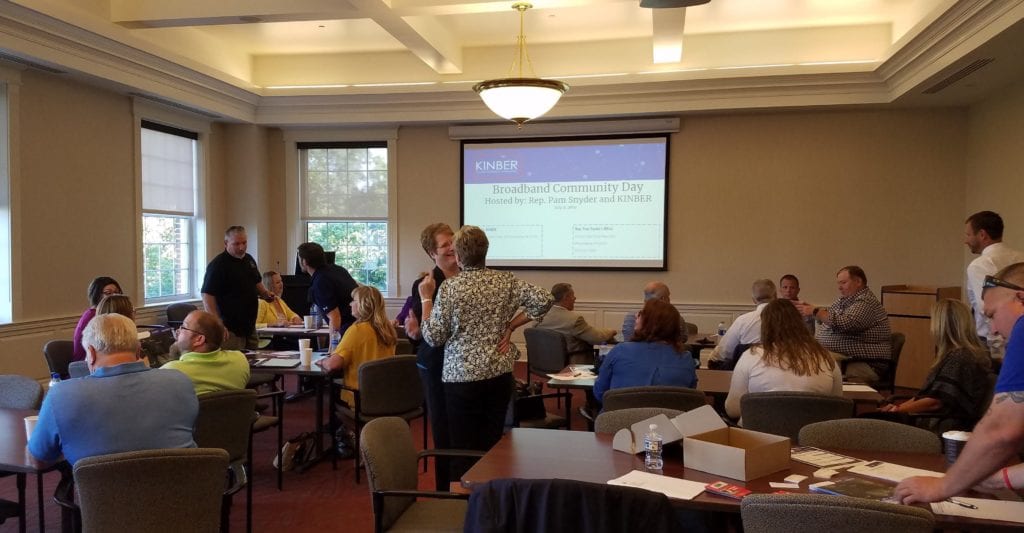Estimated reading time: 4 minutes
By Therese Perlowski, Internet2 CAP Program Manager
The coronavirus (COVID-19) pandemic has illustrated how broadband access is critical to our country’s students, businesses, and public safety. Yet many communities continue to be left behind. Pennsylvania’s research and education network, Keystone Initiative for Network Based Education and Research (KINBER), is trying to bridge this gap by making connectivity for underserved communities, which often are rural, a core part of its mission. “In the world we live in today, robust broadband connectivity is as vital as a utility,” said Austin Gamble, a business development representative for KINBER. “It’s essential to retaining talent, attracting business, and maintaining economic stability. No community should be excluded from that.”

According to a recent report by The Center for Rural Pennsylvania, there isn’t one county in the state where at least half the population receives a broadband connection. Even those with connectivity experience speed substantially slower than their urban counterparts. Working to address this, KINBER is focusing on outreach to communities in southwest Pennsylvania, such as Green, Fayette, and Washington counties. “We have really been working hard over the last couple of years to make connections in these rural areas and truly listen to them to find out what their challenges are and what they would like to see,” Gamble said of the situation.
In July 2019, KINBER worked with local and state representatives to organize a “Community Day” in Green County with the goal of bringing together local community anchor institutions and nonprofits to discuss their challenges and potential opportunities related to broadband access. The meeting included approximately 25 institutions, ranging from universities, K-12 school districts, local government, hospitals, and libraries. Community members shared that they couldn’t attract new businesses or offer telecommute opportunities because they couldn’t provide the required speeds or robust connectivity. “There is a significant need for telecommuting opportunities,” Gamble explained. “To keep the younger generation from relocating, they need people to be able to live in Green County and telecommute to bigger areas where there is a lot of opportunity, like Pittsburgh, Philadelphia and Morgantown.
Incorporating community concerns and ideas, KINBER developed an initial blueprint to expand access by connecting community anchor institutions directly to its backbone and identify outside partnerships to get infrastructure out to individual homes and private businesses. Having a plan was just a first step, though, through the process of securing funders, finding partners, and working with the community, the plan is constantly evolving, and is not without its challenges.
Through these community conversations, KINBER engaged several key state representatives and senators who were passionate about the project and able to secure potential funding sources. The support of these figures also bolstered community support.
“This is where the importance of working with your state senators and representatives comes from, because they know who to approach and how to help you achieve your goals,” Gamble said. “They can approach key stakeholders in partnership with you and generate support by conveying a different outlook on how they are able to have a long lasting, deep impact in their communities by participating in the project”. Gamble also said that it’s hard to identify anchor institutions that are forward thinking enough or willing to commit to a project in such early stages. “It’s challenging because we can’t give them any solid guarantees as we work through the process. So most of them are on board with the idea but take a ‘call us when it’s ready’ approach.” Overall, Gamble stressed the importance of flexibility, “Sometimes what is needed falls outside the scope of what we can do, and collaboration offers potential solutions. But we have to constantly evaluate which solution is going to best fit our mission and ultimately the goals of the communities we serve.”
As KINBER continues to evaluate potential commercial and community partners, it remains committed to the goal of closing the digital divide. “Bringing this project to fruition is going to enrich the community as a whole and bring underserved areas up in the ranks to allow Pennsylvania to continue to be an economic leader in our country,” Gamble said. KINBER hopes to finalize agreements and learn about funding decisions by later this spring. As Gamble shared, “We are a trusted technology partner in Pennsylvania, and we’re here to help the community achieve their agenda and serve the people the best way we can.”
Network Statistics
- On the web: https://kinber.org/
- Twitter: @KINBER
- Facebook: https://www.facebook.com/Keystone-Initiative-for-Network-Based-Education-and-Research-188743104566075/
- Community Anchor Program Member since: 2001
- Institutions Served:
- K-12 Schools/School Districts: 5
- 4-Year Universities: 63
- Community Colleges: 14
- Healthcare Institutions: 4
- Libraries/Library Systems: 32
- Public Media Stations: 1
- State/Local Government: 8
- Other: 10
Related articles and blog posts: